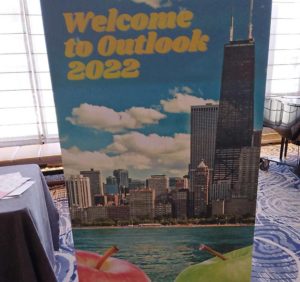
While Eastern U.S. states expect a large apple crop this year, the nation’s largest producer expects another harvest on the smaller side. That could be a blessing and a curse for Washington.
The relatively smaller crop should drive up prices and, therefore, grower returns, but it could cost Washington retail shelf space and leave packers and marketers with less of their usual advantage of scale.
“The smaller crop is likely to have both positive and negative effects,” said Desmond O’Rourke, a tree fruit economist based in Pullman, Washington.
Washington packers expect to ship about 108.7 million 40-pound box equivalents of fresh apples, down 11 percent from last year’s harvest, according to the August estimate by the Washington State Tree Fruit Association, which surveys its members to produce the annual estimate. Throw in processed apples, and Washington growers expect 110.5 million boxes. In Washington, the apple industry measures volume in 40-pound boxes instead of the 42-pound bushels reported in the Midwest and East.
Snow, rain and frost during pollination, plus a protracted, cool spring put a damper on the 2022 Washington numbers. That does carry some good news, though.
“The back-end money for the crop should be really nice,” said Keith Veselka, co-owner of NWFM, a farm management company with tree fruit acreage in Central Washington. “If you have fruit that can store, pack in May or June, that usually is really good return.”
The size of the crop gives marketers the chance to focus on places that already like Washington apples, such as the domestic market, and Mexico and Canada, especially with the high cost of freight, lingering international tariffs and the strong dollar.
“If you’re going to have a slightly lower than normal crop, this isn’t a bad time to do it,” said Jon DeVaney, president of the tree fruit association.
However, prices can only go up so much, and not enough to cover recent increases in the cost of labor, diesel, fertilizer and other inputs, DeVaney said. In fact, apple prices have held relatively steady during America’s historic wave of inflation over the past year, he said.
This year, New York and Michigan growers expect relatively large crops and enjoy an advantage in shipping to East Coast markets, especially with the high cost of freight.
Also, stores in the U.S., and internationally, will only pay so much more for apples. They may turn to other produce, hurting Washington shippers in the long run.
“Washington apples are likely to lose valuable retail shelf space to competing produce items in the U.S. and face reduced export opportunities,” O’Rourke said. “A strategy will be needed to recover that shelf space and export markets if there is a more normal crop next year.”
Meanwhile, the cool spring caused some disorders associated with chilling injury, such as soft scald, soggy breakdown and internal browning, said Byron Phillips, a crop adviser for Wilbur-Ellis in Wenatchee.
“The long, cold spring of 2022 continues to be a harsh and unforgiving teacher,” Phillips said on social media.
The problems were not widespread but rather isolated to a few late-blooming blocks, Phillips said in a follow-up conversation with Good Fruit Grower.
Normally, such conditions show up after apples have been stored too cold. Wilbur-Ellis field staff began noticing them in July, Phillips said.
One bright spot is a larger crop of WA 38 apples, marketed as Cosmic Crisp, giving shippers and marketers more volume of the high-value fruit to work with this year. Growers expect 5 million fresh boxes of WA 38, which would be 4.5 percent of the overall fresh crop. WA 38 is the only non-club variety expected to grow in volume this year.
“Yes, I believe we are well on our way to reach critical volume,” said Kevin Brandt, vice president of Proprietary Variety Management, the Yakima company contracted by Washington State University to commercialize the WA 38. “Critical volume being year-round product — at least within the U.S.”
The rising WA 38 volume could generate some excitement in the export market, too. The Washington Apple Commission has marketing programs ready for those extra apples in Canada, Mexico, Taiwan and Vietnam, the four countries that accounted for nearly all of the WA 38 export volume in the 2021–22 shipping season. (See “Exporting Cosmic Crisp.”)
Also, organic apples continue to fetch a premium, DeVaney said. Growers expect about 14,400 boxes of fresh organic apples, roughly the same as last year. However, the organic crop is expected to account for 13 percent of the 2022 harvest, compared to 12 percent last year.
—by Ross Courtney









Leave A Comment